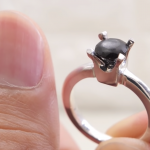You know the picture. The proposer suddenly lowers the knee to the ground, both hands clutching a tiny box. “Will you marry me?” they ask. It’s a picturesque moment, one we’ve seen reproduced time and time again. But why do we do it?
While proposing has actually been around for centuries, proposing on bended knee specifically has not always been the tradition. In the olden days, wedding engagements were seen more as business arrangements than the romantic, heartfelt scenes we know today.
Proposing on bended knee has no specific historical origin, and largely seems to be a more modern invention.
Most reports link the tradition to practices observed during medieval times.
According to engagementringbible.com, the tradition “dates back to the days of knighthood, chivalry and formal courtship (i.e. medieval times and beyond).” In these days, knights would bend the knee in front of their lord as a sign of respect and loyalty. Courtly love was the formal practice of romance. Knights would perform various deeds of service to prove their love for certain women. They would also kneel before the women as a sign of servitude.
Kneeling was and is a common occurrence across many religions. Much Christian iconography depict figures kneeling before their Lord as a symbol of service. For many entering their places of worship, they will kneel before the altar in a sign of love and reverence.
The argument goes that these two occurrences blended together and became a way for people to express their love, thus evolving into the modern day proposal. The bended knee became a symbolic way to prove your undying love and respect.
Nowadays, of course, people are not so strict about upholding this tradition. Many propose without kneeling, and the amount of women proposing to men has largely risen. Whether you kneel or not, at the end of the day it is about what feels right for you and your partner.
Image: Unsplash




















